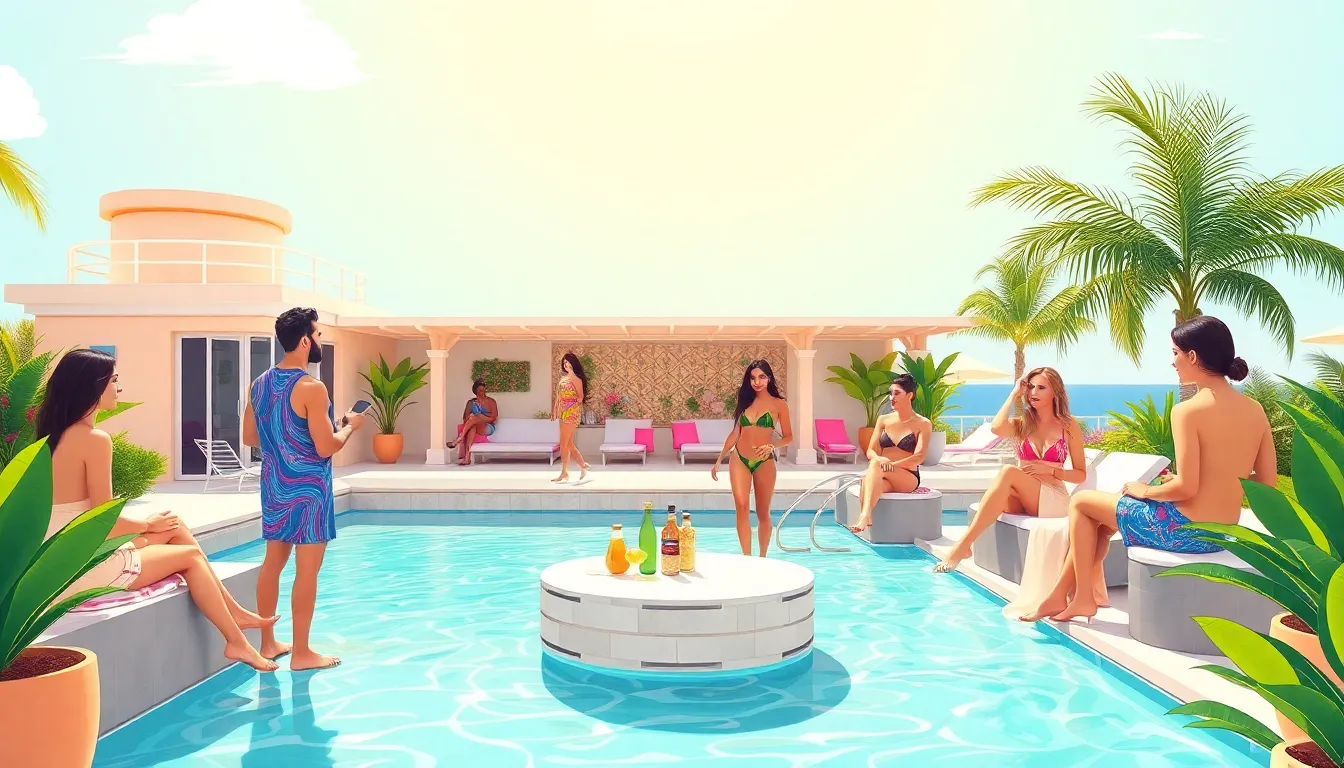Love Island has taken the reality TV world by storm, captivating audiences with its sun-soaked drama and steamy romances. But amidst all the swoon-worthy moments, one burning question lingers: is it really filmed in real time? Fans often wonder if those heart-pounding recouplings and jaw-dropping betrayals unfold as they watch or if there’s a bit of behind-the-scenes magic at play.
Table of Contents
ToggleOverview of Love Island
Love Island captivates audiences with its blend of romance and drama. Contestants, known as islanders, participate in challenges, form relationships, and navigate complex dynamics as they seek love. Viewers become emotionally invested in the ups and downs of these connections.
The format of the show differs from traditional reality television, with a focus on daily interactions in a luxury villa. Producers curate tasks and events to heighten tension, including games that test relationships. Recouplings occur regularly, adding unpredictability to islanders’ fates. Contestants are often eliminated based on public votes, which keeps the viewer engaged.
In terms of filming, conversations arise regarding the timeline of the events. Unlike many other reality shows, Love Island creates an illusion of real-time experiences, but there are production methods at play. Hours of footage are edited into nightly episodes, shaping narratives to fit a cohesive storyline.
Fans often speculate about how much of the emotional drama arises spontaneously and how much is influenced by editing. While it seems authentic, the reality is that certain events may be subtly manipulated to create suspense. Despite questions of authenticity, the excitement and unpredictability drive viewership and keep audiences coming back for more.
Challenges occur weekly, providing entertainment while allowing viewers to see different sides of the islanders. Each season introduces new contestants who bring fresh conflicts and alliances. The combination of intense relationships and strategic gameplay generates significant buzz on social media, further fueling interest in the series.
Filming Process of Love Island

The filming process of Love Island creates a unique viewing experience. Producers follow a structured timeline with specific schedules and techniques to capture the drama and romance.
Production Schedule
Casting for Love Island typically occurs months before filming starts. Once selected, contestants enter a villa where filming lasts approximately eight weeks. Each day involves several hours of shooting, often leading to long days for the islanders. Daily activities include challenges, individual conversations, and group interactions, all contributing to a dynamic atmosphere. While viewers see nightly episodes, much of the real-time content is edited to fit a concise format. This editing process shapes the narrative, emphasizing key moments that resonate with audiences.
Filming Techniques
Cameras capture nearly every moment inside the villa, ensuring nothing goes unnoticed. Multiple angles allow producers to create tension and build emotional depth through selective editing. Camera teams utilize drones for aerial shots, enhancing visual appeal and providing context. Besides fixed cameras, handheld devices facilitate capturing candid interactions among islanders. Producers often conduct interviews to give insight into contestants’ thoughts and feelings, adding layers to the storytelling. These techniques work in tandem to create a narrative that, while edited, feels immediate and engaging to fans.
Is Love Island Filmed in Real Time?
Fans often wonder about the timeline of events on Love Island. While the show creates a sense of immediacy, several factors influence the perception of real-time filming.
Evidence Supporting Real-Time Filming
Islanders participate in daily activities that appear spontaneous and engaging. Each episode showcases activities like challenges and recouplings, which seem to unfold in real time. Viewers can feel the emotional highs and lows as contestants bond and navigate conflicts. The quick succession of events contributes to an immersive experience, making it easy for fans to believe they’re witnessing everything as it happens. Some cast members have even noted the intensity of filming every moment, further enhancing the illusion of real-time dynamics.
Evidence Against Real-Time Filming
Behind-the-scenes practices establish a different narrative. Despite the show’s engaging presentation, producers edit hours of footage into condensed nightly episodes. Filming occurs over approximately eight weeks, but only highlights of those experiences reach the screen. Many islanders reveal that key moments often happen off-camera, losing the spontaneity viewers expect. Strategic editing shapes how events are portrayed, influencing the storyline. Interviews with contestants are strategically placed to deepen viewer engagement but can also alter the perception of time and events, further obscuring the true filming timeline.
Impact of Filming Schedule on Contestants
The filming schedule of Love Island significantly impacts contestants’ experiences and relationships. Contestants often find themselves in an environment designed to amplify emotions and tension. Daily activities and challenges create opportunities for bonding and conflict, all influenced by the show’s production timeline.
Producers craft a tightly controlled schedule that dictates when challenges occur and how contestants interact. Various activities unfold throughout the day, while cameras capture every moment. Each edited episode reflects only a fraction of contestants’ experiences, making viewers unaware of behind-the-scenes actions.
Emotions evolve quickly in the villa, yet not all interactions reach the screen. Off-camera moments often shape relationships, but viewers never see them. Producers create a narrative by selecting which moments to highlight, leaving fans questioning the authenticity of emotional developments.
Contestants may feel a mix of genuine connections and performative aspects. The intense setup can lead to both true love and strategic alliances, as islanders navigate their choices. Decisions regarding whom to couple with can stem from actual feelings or calculated strategies for survival in the game.
Nature of the filming schedule often weighs heavily on contestants’ mental states. Stress and pressure can arise from public voting and elimination, contributing to heightened emotional stakes. Island dynamics shift rapidly, with alliances forming and breaking, making trust a fragile concept in the eye of the viewer.
Contestants also adjust to the constant presence of cameras and producers. Privacy remains minimal, as personal moments become public experiences. Such exposure can amplify feelings of vulnerability or lead to stronger connections among islanders striving for shared understanding in the face of scrutiny.
Love Island continues to engage fans with its mix of romance and drama despite questions about its filming timeline. While it gives the illusion of real-time events the reality is that production techniques shape the narrative viewers see. Editing plays a crucial role in condensing hours of footage into captivating episodes, influencing perceptions of spontaneity and authenticity.
The emotional stakes for contestants remain high as they navigate relationships under constant scrutiny. Even though some moments are genuine the pressure of the environment can lead to performative behavior. This complex dynamic keeps audiences hooked while raising intriguing questions about the nature of reality television and the true experiences of those involved.




